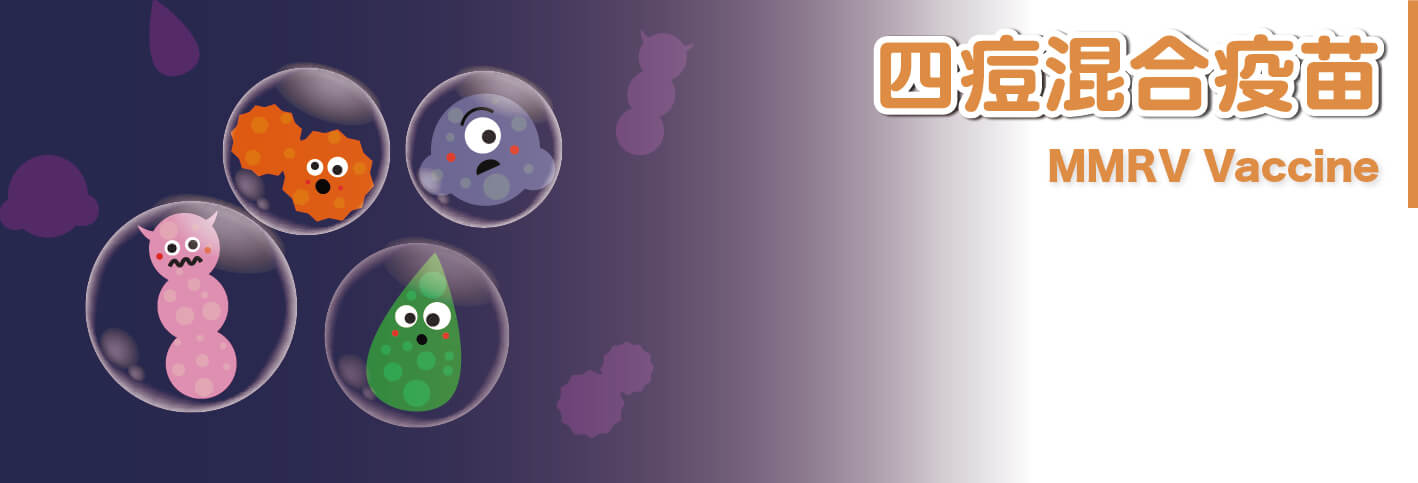
The MMRV vaccination is a vaccine that protects against four different diseases.
Measles, mumps, rubella, and varicella (chickenpox) are the four illnesses.

|
It is a highly contagious sickness caused by the measles virus. Infected individuals initially experience a fever, cough, runny nose, red eyes, and white patches in the mouth. Measles can be transmitted via airborne droplets or direct contact with patient nasal and throat secretions. |

|
Caused by mumps virus Swollen and painful salivary glands, commonly localized in the cheeks, are symptoms. The virus can be transferred through direct contact with a sick person's saliva or droplets. |

|
due to the rubella virus Infected persons experience fever, cough, runny nose, red eyes, and white patches at first. Rubella can be transmitted through contact with patients' nasopharyngeal secretions; thus, contact with droplets or direct contact with patients may result in infection. |

|
Varicella-zoster virus-induced acute infectious illness Patients typically develop a fever and an itchy rash, which emerges in waves over the course of around 5 days. Mostly by droplets or air, but also through direct or indirect contact with pathogen-carrying blister fluid from chickenpox or herpes zoster patients, which is disseminated by mucosal secretions. |
The Varicella vaccine injection provided in the government vaccine program and the 3-in-1 injection of MMR vaccine, a total of 3 injections throughout the injection process, and the newly launched MMRV vaccine, in addition to preventing chickenpox, also has measles, mumps and German measles, MMRV combines the varicella injection that needs to be injected separately and the 3-in-1 injection of measles, mumps and rubella. The combined vaccine not only reduces the number of injections by one, but also provides full protection to the infant before the 15th month. After two doses of vaccination, up to 99.8% of chickenpox immune responses can be elicited.
People who have been immunized against chickenpox can still get it (a condition known as "breakthrough infection"), but the symptoms are frequently milder or less characteristic, and the number of blisters is reduced. The rash is frequently maculopapular as opposed to vesicular. Those who have received vaccinations are shorter, however those who have not received vaccinations may have 300 or more irritating blisters at the time of commencement.
Vaccine name |
ProQuad |
|
Pharmaceutical company |
US MSD | |
Suitable for |
Intentionally reduce the number of injections |
|
Effective Prevention |
Chickenpox, measles, mumps, and rubella |
|
Inoculation time |
Two doses are required, and vaccinations are advised at 12 and 15 months (the time between the two doses should be at least one month). |
|
Side Effects |
After immunization, pain, slight fever, redness or rash at the injection site, and swollen glands in the cheeks or neck may occur, but recovery is quick. If these symptoms arise, they usually do so within two weeks following vaccination. After the second dose, it is less likely to occur. |
|
Not suitable for |
Hypersensitivity to any vaccination components |
|
Precautions |
If MMR or varicella vaccination was given at 12 months of age, it can be given between 15 months and 6 years of age. Inject the second dose of MMRV combination vaccination, allowing at least one month between injections. |
|
Age |
Current Government Vaccination Program |
Medtimes MMRV Vaccination Service |
|
1 year old |
Varicella vaccine (1st dose)
|
MMRV Vaccine (1st dose) |
|
15 months old (the ealiest) |
- |
MMRV Vaccine (2nd dose) |
|
18 months old |
MMR vaccine (3rd dose) |
- |
|
6 years old (Primary 1)
|
MMR vaccine (3rd dose) |
- |
|
|
Total 3 doses |
Total 2 doses |

完成測試後,有機會獲免費骨質密度檢查 (DEXA) 乙次 或 骨質密度檢查優惠券乙張
閣下資料將會用作此推廣活動聯絡用途,如因資料有誤而未能聯絡閣下,本公司一概不負上任何責任。